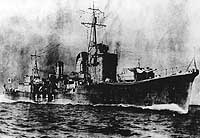
Yukikaze, a 2033-ton Kagero class destroyer built at Sasebo, Japan, was commissioned in January 1940. In December 1941, a few days after the beginning of the Pacific War, she supported landings at Legaspi, Luzon, and during the first two months of the next year was employed in the campaign to seize the Dutch East Indies. On 27 February 1942 Yukikaze was part of the Japanese cruiser-destroyer force that defeated the Allied naval units in the Battle of the Java Sea.
Yukikaze screened troop transports during the Battle of the Midway in June 1942. She was next in action in the long and difficult Guadalcanal Campaign, serving as an escort in the carrier battles of the Eastern Solomons in August and the Santa Cruz Islands in October. She also participated in the chaotic night action off Guadalcanal on the night of 13 November 1942. In March 1943 Yukikaze was one of the few Japanese ships that survived relentless U.S. Air Force attacks during the Battle of the Bismarck Sea. Four months later, in mid-July, she engaged Allied ships in the Battle of Kolombangara.
In the June 1944 Battle of the Philippine Sea Yukikaze served as an escort for the Japanese oilers. On 24-25 October, during the Battle of Leyte Gulf, she was part of the primary striking force which, after enduring U.S. carrier plane attacks in the Sibuyan Sea, battled American escort aircraft carriers and their destroyer companions in the Battle off Samar. Yukikaze's last major combat operation, on 7 April 1945, was as part of the force built around the battleship Yamato in a desperate, and intentionally suicidal, attempt to attack U.S. forces off Okinawa. Having escaped the air attacks that sank Yamato, Yukikaze returned to Japan. In late July 1945, shortly before the fighting ended, she was damaged by a mine, but was apparently not seriously hurt.
One of the handful of Japan's larger destroyers (out of a hundred) to survive the war in serviceable condition, she was disarmed for use bringing Japanese military personnel and civilians home from that nation's former overseas empire. In July 1947, shortly after this task was completed, Yukikaze was transferred to the Chinese Navy, which renamed her Tan Yang. She accompanied the Nationalist Government to Taiwan after it was driven from the mainland in 1949 and continued in service for two more decades. The old destroyer was scrapped in 1971.
This page features all the images we have concerning the Japanese destroyer Yukikaze.
| If you want higher resolution reproductions than the digital images presented here, see: "How to Obtain Photographic Reproductions." |
Click on the small photograph to prompt a larger view of the same image.
|
Photo #: NH 73052 Yukikaze (Japanese destroyer, 1940) Underway off Sasebo, Japan, in January 1940. Donation of Kazutoshi Hando, 1970. U.S. Naval Historical Center Photograph. Online Image: 97KB; 740 x 535 pixels |
 |
|
Photo #: SC 286588 Yukikaze (Japanese Destroyer, 1940) At Tokyo, Japan, on 26 May 1947, for display to representatives of the United States, Great Britain, the USSR and China. She later became the Republic of China Navy's destroyer Tan Yang. Yukikaze had been employed repatriating Japanese Nationals from overseas and was stripped of armament for this purpose. Photographed by Kaye Calmus. Note that Yukikaze retains her external degaussing cables, which are attached to her hull below deck level. Photograph from the Army Signal Corps Collection in the U.S. National Archives. Online Image: 54KB; 600 x 765 pixels Reproductions of this image may also be available through the National Archives photographic reproduction system. |
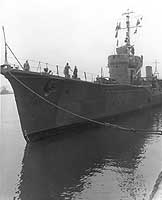 |
|
Photo #: SC 286590 Yukikaze (Japanese Destroyer, 1940) View of the ship's forward superstructure, taken at Tokyo, Japan, on 26 May 1947. She was then ready for display to representatives of the principal Allied powers and had previously been employed repatriating Japanese nationals from overseas. She later became the Republic of China Navy's destroyer Tan Yang. Note the horn-shaped radar antennas on Yukikaze's foremast and the long galley smoke pipe running from her forecastle to the port side of her forward smokestack. Photographed by Kaye Calmus. Photograph from the Army Signal Corps Collection in the U.S. National Archives. Online Image: 582KB; 740 x 620 pixels Reproductions of this image may also be available through the National Archives photographic reproduction system. |
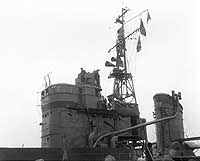 |
|
Photo #: SC 286589 Yukikaze (Japanese Destroyer, 1940) View on the ship's deck, looking aft from her bow. Taken at Tokyo, Japan, on 26 May 1947, where she is to be exhibited to representatives of the leading Allied powers. The escort ship Shisaka is at right. Both ships had been employed repatriating Japanese nationals from overseas, and were stripped of armament for this service. They were later transferred to the Chinese Navy. Note Yukikaze's deck plating, with raised plates attached for non-skid purposes, and her anchor and line handling equipment. Photographed by Kaye Calmus. Photograph from the Army Signal Corps Collection in the U.S. National Archives. Online Image: 82KB; 600 x 765 pixels Reproductions of this image may also be available through the National Archives photographic reproduction system. |
 |
|
Photo #: SC 286587 Shisaka (Japanese Escort Ship, 1945), at left, and Yukikaze (Japanese Destroyer, 1940) At Tokyo, Japan, on 26 May 1947, for display to representatives of the leading Allied powers. Both ships were used to repatriate Japanese nationals from overseas and had been stripped of their armament for this purpose. They were later transferred to the Chinese navy. Photographed by Kaye Calmus. Note that Yukikaze retains her external degaussing cables, which are attached to her hull below deck level. Photograph from the Army Signal Corps Collection in the U.S. National Archives. Online Image: 62KB; 740 x 615 pixels Reproductions of this image may also be available through the National Archives photographic reproduction system. |
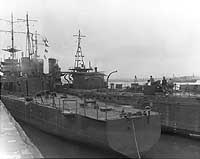 |
|
Photo #: SC 286586 Yukikaze (Japanese Destroyer, 1940) View in the ship's pilot house, taken at Tokyo, Japan, on 26 May 1947, after she had served as a repatriation ship for Japanese nationals. Yukikaze was to be on display for representatives of the major Allied powers. She later became the Republic of China's destroyer Tan Yang. Photographed by Kaye Calmus. Note the binoculars, voice tubes and wooden deck gratings. Photograph from the Army Signal Corps Collection in the U.S. National Archives. Online Image: 108KB; 740 x 615 pixels Reproductions of this image may also be available through the National Archives photographic reproduction system. |
 |
|
Photo #: SC 286585 Yukikaze (Japanese Destroyer, 1940) View in the ship's engine control room, taken at Tokyo, Japan, on 26 May 1947, after she had served as a repatriation ship for Japanese nationals. "Controls have been labeled with English translations explaining functions of the various instruments, wheels and dials for the benefit of American officers working with the ship's Japanese crew. Of all the repatriation ships, Yukikaze has been kept in perfect working conditions. A tribute to the pride of her Japanese crew." (quoted from the original 1947 picture caption). Taken over by China in July 1947 she had long service as the Republic of China's destroyer Tan Yang. Photographed by Kaye Calmus. Photograph from the Army Signal Corps Collection in the U.S. National Archives. Online Image: 125KB; 740 x 610 pixels Reproductions of this image may also be available through the National Archives photographic reproduction system. |
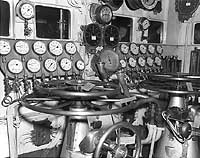 |
| If you want higher resolution reproductions than the digital images presented here, see: "How to Obtain Photographic Reproductions." |
Page made 28 February 2006